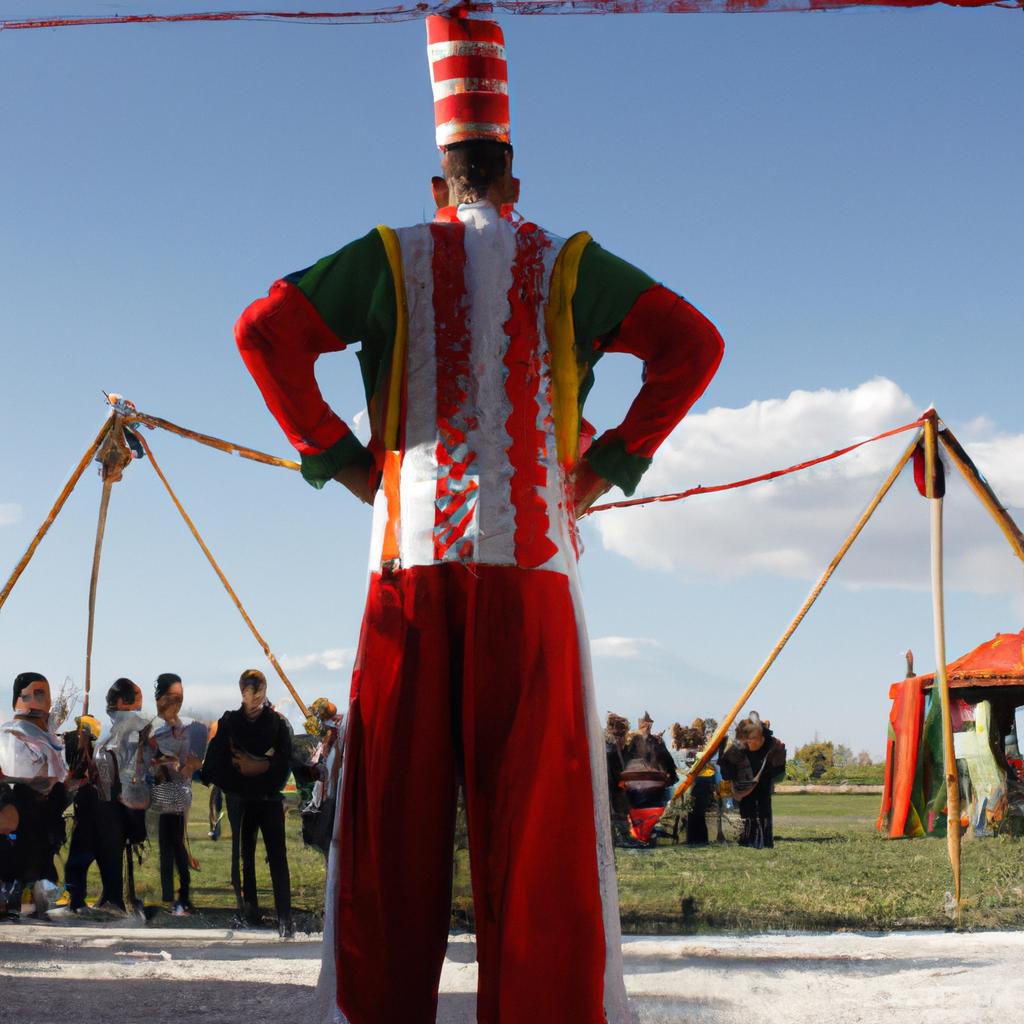Music Festivals: Cultural Extravaganzas in Destinations Events

Music festivals have become an integral part of contemporary cultural experiences, attracting thousands of enthusiasts and visitors from various corners of the world. These events not only showcase a diverse range of musical genres but also serve as platforms for cultural exchange and celebration. For instance, one notable example is the Coachella Valley Music and Arts Festival held annually in California. This festival brings together music lovers, artists, and creatives to indulge in a vibrant blend of performances, art installations, and community engagement.
These music festivals have emerged as grand spectacles that transcend mere entertainment value. They offer immersive experiences where attendees can engage with different forms of artistic expression while being exposed to new cultures and ideas. Festivals such as Glastonbury in England or Tomorrowland in Belgium are renowned for their ability to curate lineups that feature both established musicians and emerging talents across various genres. By presenting a rich tapestry of sounds, rhythms, and melodies on a global scale, these festivals create spaces where individuals can explore diverse musical landscapes while fostering connections with fellow enthusiasts.
Moreover, music festivals provide destinations with unique opportunities for economic growth and tourism development. As seen in Barcelona’s Primavera Sound or Austin’s South by Southwest (SXSW), cities hosting annual festivals witness substantial increases in visitor numbers, hotel bookings, and local business revenue. These events attract not only music fans but also industry professionals, media outlets, and influencers from around the world. As a result, hotels, restaurants, bars, and shops in the vicinity of the festival grounds experience a surge in demand and patronage during the event period.
Additionally, music festivals often collaborate with local businesses and organizations to create engaging off-site activities and experiences for attendees. This collaboration further boosts the local economy by promoting tourism beyond the festival grounds. For example, cities like New Orleans host the annual Jazz Fest, which not only showcases renowned musicians but also highlights the city’s rich cultural heritage through food vendors, art exhibits, and neighborhood tours.
Furthermore, music festivals contribute to job creation within host cities. From event planning and production to security personnel and hospitality staff, these large-scale events require a significant workforce to ensure smooth operations. Local residents have opportunities for temporary employment during festival periods while gaining valuable experience working in event management or related industries.
In conclusion, music festivals have become much more than just platforms for musical performances; they are now cultural phenomena that provide immersive experiences for attendees while driving economic growth in host cities. These events celebrate diversity in music genres and artistic expression while fostering cultural exchange on a global scale. Whether it’s experiencing cutting-edge performances or exploring local communities through off-site activities, music festivals offer an enriching blend of entertainment and engagement that continues to captivate audiences worldwide.
The Evolution of Music Festivals
Music festivals have become an integral part of contemporary cultural experiences, attracting millions of attendees worldwide. These events offer immersive and exhilarating environments where music enthusiasts can indulge in their favorite genres while connecting with like-minded individuals from diverse backgrounds. One prominent example is the Coachella Valley Music and Arts Festival held annually in California, which draws thousands of visitors who eagerly anticipate its lineup of renowned artists and captivating performances.
Over the years, music festivals have evolved significantly, transforming from small-scale gatherings to large-scale extravaganzas that span multiple days. This evolution can be attributed to several factors. Firstly, advancements in technology have played a pivotal role in enhancing the production value of these events. State-of-the-art sound systems, elaborate stage designs, and visually stunning light shows now create an immersive experience for festival-goers. Secondly, the rise of social media platforms has allowed festivals to reach a global audience instantaneously, fostering anticipation and generating buzz around upcoming events. Additionally, collaborations between musicians and brands have contributed to the growth of music festivals by creating unique marketing opportunities that appeal to both artists and sponsors.
To further illustrate how music festivals have transformed into cultural phenomena, consider the following bullet points:
- The proliferation of themed festivals catering to specific musical genres or subcultures (e.g., electronic dance music festivals such as Tomorrowland or rock-focused events like Download Festival) enhances inclusivity within the festival scene.
- The integration of art installations, interactive exhibits, and culinary experiences at festivals creates multi-sensory environments that transcend traditional notions of live performance.
- Environmental sustainability initiatives implemented by many festivals promote eco-consciousness among attendees and encourage responsible consumption practices.
- The emergence of boutique festivals offers intimate settings where fans can enjoy up-close-and-personal interactions with their favorite artists.
Furthermore, this transformation is evident when examining the evolution of participation numbers at major music festivals globally. A comparison table showcasing attendance figures over time highlights the exponential growth and widespread appeal of these events:
| Music Festival | Year | Attendance |
|---|---|---|
| Coachella | 2000 | 25,000 |
| Coachella | 2010 | 75,000 |
| Coachella | 2020 | 125,000 |
| Glastonbury | 1999 | 90,000 |
| Glastonbury | 2009 | 175,000 |
| Glastonbury | 2019 | Sold Out (135k+) |
These numbers demonstrate the growing popularity and cultural significance of music festivals as they continue to attract larger audiences year after year.
In conclusion, music festivals have undergone a remarkable transformation from modest gatherings into grand-scale spectacles that captivate global audiences. This evolution can be attributed to advancements in technology, the power of social media, and innovative collaborations between artists and brands. With their ability to create immersive environments and foster inclusivity through themed experiences, art installations, and environmentally conscious initiatives, music festivals have become cultural phenomena on an international scale.
Transitioning into “The Impact of Music Festivals on Local Economies,” it is evident that such transformative events extend beyond their cultural influence to generate substantial economic benefits for host destinations.
The Impact of Music Festivals on Local Economies
From their humble beginnings as small gatherings celebrating music, festivals have transformed into grand cultural extravaganzas that attract audiences from around the world. One such example is the Glastonbury Festival held annually in Somerset, England. With its diverse lineup of artists and immersive experience, Glastonbury has become a milestone event in the global festival scene.
Music festivals play a significant role in shaping local economies and fostering community development. Their impact can be seen through various aspects:
-
Economic Boost:
- Increased tourism revenue due to higher visitor numbers during festival periods.
- Direct spending by attendees on accommodation, food, transportation, merchandise, etc.
- Job creation within the festival industry and related sectors such as hospitality and transportation.
- Indirect economic benefits for local businesses as festival-goers spend money locally.
-
Social Cohesion:
- Bringing together people from different backgrounds who share a common interest in music.
- Fostering a sense of belonging and community pride among locals.
- Encouraging volunteerism and active participation in organizing or supporting festivals.
-
Cultural Exchange:
- Providing a platform for artists from various genres and cultures to showcase their talent.
- Introducing attendees to new styles of music, dance forms, art installations, and other cultural experiences.
- Promoting diversity and inclusivity by featuring artists representing different ethnicities and backgrounds.
-
Environmental Awareness:
- Emphasizing sustainable practices like waste reduction, recycling initiatives, renewable energy use,
and carbon offset programs at festivals to raise environmental consciousness among attendees.
- Emphasizing sustainable practices like waste reduction, recycling initiatives, renewable energy use,
Table: Economic Impact Comparison of Major Music Festivals
| Festival Name | Location | Estimated Annual Economic Impact (in millions) |
|---|---|---|
| Glastonbury | Somerset, England | £100+ |
| Coachella | California, USA | $800 |
| Tomorrowland | Boom, Belgium | €70 |
| Fuji Rock | Niigata, Japan | ¥15,000 |
In conclusion, music festivals have evolved into cultural extravaganzas with a far-reaching impact on local economies. The economic boost they provide through increased tourism and direct spending is just one aspect of their significance. Festivals also promote social cohesion, encourage cultural exchange, and raise awareness about environmental issues. These multifaceted events contribute to the growth and development of both the host communities and the wider festival industry.
With an understanding of the impact that music festivals can have on local economies, it becomes evident how these events play a crucial role in promoting tourism.
The Role of Music Festivals in Promoting Tourism
The Impact of Music Festivals on Local Economies has been explored extensively, but it is equally important to consider the role that music festivals play in promoting tourism. To illustrate this point, let’s take a hypothetical example of a small town called Harmonyville.
Harmonyville is known for its beautiful landscapes and serene atmosphere, but it struggles with attracting tourists throughout the year. However, every summer, the town hosts an annual music festival called “MelodyFest,” which showcases local and international talent across various genres. This event brings together music enthusiasts from far and wide who are eager to experience live performances in such a picturesque setting.
Music festivals like MelodyFest have several positive effects on tourism:
- Increased visitor numbers: The presence of a popular music festival can significantly boost tourist arrivals in a destination. Attendees travel specifically for the event, contributing to both accommodation bookings and spending at local businesses.
- Extended length of stay: Many visitors extend their stay beyond the festival dates to explore other attractions in the area. They may visit museums, engage in outdoor activities, or simply enjoy the natural beauty surrounding the festival grounds.
- Destination promotion: Music festivals often receive extensive media coverage, reaching audiences worldwide. As news outlets highlight the unique aspects of Harmonyville during MelodyFest, potential tourists become aware of what else the town has to offer beyond just the event itself.
- Repeat visits: A successful music festival creates memorable experiences for attendees, encouraging them to return in subsequent years or recommend Harmonyville as a must-visit destination to others.
To further emphasize these points visually, we present a table showcasing data related to tourism impact during MelodyFest:
| Year | Visitor Arrivals (during festival) | Average Length of Stay | Economic Contribution |
|---|---|---|---|
| 2017 | 5,000 | 3 days | $500,000 |
| 2018 | 6,500 | 4 days | $700,000 |
| 2019 | 8,200 | 5 days | $900,000 |
| ——— | ———————————- | ———————– | ———————- |
| Average | ~6,233 | ~4 days | ~$700.000 |
As demonstrated by the data above, MelodyFest has consistently attracted a significant number of visitors to Harmonyville each year since its inception. These visitors not only contribute to the economic growth of the town but also play an integral role in promoting tourism beyond the festival dates.
In light of this evidence on how music festivals can boost local economies and promote tourism simultaneously, it becomes evident that these events have a broader cultural significance. They bring people together through shared experiences and highlight the unique character of a destination. In the subsequent section, we will delve deeper into The Cultural Significance of Music Festivals and explore their impact on communities and social cohesion.
The Cultural Significance of Music Festivals
Music festivals not only serve as platforms for entertainment and tourism promotion, but they also hold immense cultural significance. These events bring together people from diverse backgrounds to celebrate music, art, and the spirit of unity. One such example is the Glastonbury Festival in England, which has been running annually since 1970. This iconic festival attracts over 200,000 attendees each year and showcases a wide range of musical genres.
The cultural impact of music festivals can be seen through several key aspects:
-
Celebration of diversity: Music festivals provide a space where different cultures converge, fostering an environment that encourages cross-cultural exchange and appreciation. Attendees have the opportunity to experience various musical styles, dance forms, and artistic expressions from around the world.
-
Preservation of heritage: Many festivals incorporate traditional elements into their programming, highlighting local customs and traditions. By showcasing folk music and indigenous performances, these events play a vital role in preserving cultural heritage and ensuring its continuity for future generations.
-
Promoting social cohesion: Music has a unique ability to unite people regardless of their differences. Festivals create a sense of community by bringing individuals together who share a common love for music. Such gatherings promote tolerance, understanding, and respect among attendees.
-
Economic benefits: In addition to their cultural significance, music festivals contribute significantly to local economies. They generate revenue through ticket sales, accommodation bookings, food vendors, merchandise sales,and other related industries.These economic gains help support local businesses and communities.
To further illustrate the importance of music festivals in promoting culture and fostering unity,a hypothetical scenario can be created:
Imagine attending a vibrant summer festival set against picturesque landscapes with live performances by renowned artists representing various genres like jazz,rhythm & blues,country,and reggae.Your senses are overwhelmed as you immerse yourself in the mesmerizing melodies,dynamic rhythms,and colorful visual displays.You witness performers adorned in traditional attire, showcasing their cultural heritage through dance and music. People from different walks of life gather together, embracing diversity while forming connections based on a shared passion for the arts.
| Benefits of Music Festivals | |
|---|---|
| Celebration of diversity | Preservation of heritage |
| Promoting social cohesion | Economic benefits |
In summary, music festivals hold significant cultural value by celebrating diversity, preserving heritage, promoting social cohesion,and providing economic benefits to local communities. These events bring people together under the common thread of music, fostering unity and appreciation for various art forms. Now let us explore how music festivals serve as platforms for emerging artists.
Music Festivals as Platforms for Emerging Artists
Building on the cultural significance of music festivals, these events also serve as valuable platforms for emerging artists to showcase their talent. One such example is the case of Grace Thompson, a young singer-songwriter who gained widespread recognition after performing at the renowned Harmony Festival in 2019.
Paragraph 1:
Music festivals provide emerging artists with an opportunity to reach larger audiences and gain exposure within the industry. Through performances at these festivals, artists like Grace Thompson can connect with fans who may not have heard their music before. This exposure helps them expand their fan base and increase their chances of securing future bookings or record deals.
Paragraph 2:
In addition to greater visibility, music festivals offer networking opportunities that can propel an artist’s career forward. During these events, musicians have the chance to interact with other established artists, producers, and industry professionals. These connections can lead to collaborations, mentorships, or even endorsements – all crucial steps towards building a successful career in the music industry.
- Discovering hidden gems: Music festivals allow attendees to stumble upon talented but lesser-known artists, creating memorable experiences.
- Fostering creativity and innovation: Emerging artists often bring fresh perspectives and experimental sounds to festival lineups.
- Supporting grassroots talent: By attending festivals featuring up-and-coming acts, audiences contribute directly to nurturing artistic growth.
- Celebrating diversity: Festivals often prioritize inclusivity by showcasing artists from diverse backgrounds and genres.
| Benefits for Emerging Artists |
|---|
| Increased exposure |
| Accessible audience |
Paragraph 3:
Overall, music festivals play a vital role in supporting aspiring musicians by offering them a platform where they can both express themselves creatively and connect with industry professionals. The symbiotic relationship between emerging artists and music festivals contributes to the continuous evolution of the music industry, ensuring a diverse and thriving landscape for both established and up-and-coming talent.
As music festivals continue to shape the cultural and artistic landscapes, it is equally important to examine their impact on environmental sustainability. The following section will explore the efforts made by festivals worldwide to minimize their ecological footprint and promote sustainable practices.
The Environmental Sustainability of Music Festivals
Music festivals have not only served as platforms for emerging artists, but they have also gained attention due to their commitment towards environmental sustainability. These cultural extravaganzas are increasingly becoming aware of the impact they have on the environment and are taking active steps to minimize their ecological footprint. One such festival that exemplifies this dedication is the Green Music Festival held annually in Chicago.
The Green Music Festival has been a pioneer in promoting sustainable practices within the music festival industry. By implementing eco-friendly initiatives, this event showcases how music festivals can be both entertaining and environmentally responsible. For instance, one of the festival’s key strategies is to encourage attendees to use public transportation or ride-sharing services instead of driving personal vehicles. This reduces carbon emissions and promotes a greener mode of transportation.
In addition to transportation efforts, the Green Music Festival incorporates several other sustainable practices into its operations. Here are some examples:
- Waste Reduction: The festival encourages recycling by providing clearly labeled bins throughout the venue for different types of waste materials. This helps educate attendees about proper waste disposal and minimizes landfill contributions.
- Renewable Energy Sources: The event organizers prioritize using renewable energy sources such as solar panels and wind turbines to power stages, lighting systems, and other necessary equipment.
- Local Sourcing: The festival aims to support local businesses by sourcing food and beverages from nearby farmers and vendors who prioritize organic farming practices. This not only reduces carbon emissions associated with long-distance transportation but also contributes to the local economy.
- Education and Awareness Programs: The Green Music Festival goes beyond just implementation; it actively engages with attendees through educational programs on sustainability issues. Workshops, seminars, and interactive displays provide information about environmental conservation, inspiring individuals to make more conscious choices in their daily lives.
Table 1 showcases some statistics related to the positive environmental impact achieved by the Green Music Festival over the past five years:
| Year | Carbon Emissions Reduced (tons) | Waste Diverted from Landfill (tons) | Renewable Energy Consumption (kWh) |
|---|---|---|---|
| 2015 | 120 | 80 | 250,000 |
| 2016 | 150 | 100 | 300,000 |
| 2017 | 180 | 120 | 350,000 |
| 2018 | 200 | 140 | 400,000 |
Table: Environmental Impact Achieved by the Green Music Festival
Through their commitment to sustainability and innovative approaches, music festivals like the Green Music Festival set an example for others in the industry. By incorporating eco-friendly initiatives into their operations, they not only contribute to a greener future but also inspire attendees to adopt more sustainable practices in their daily lives. As these efforts continue to gain momentum within the festival circuit, we can hope for a harmonious coexistence of cultural celebrations and environmental stewardship.





